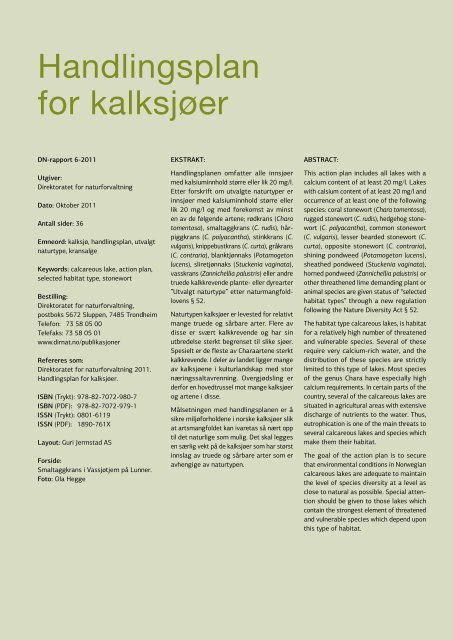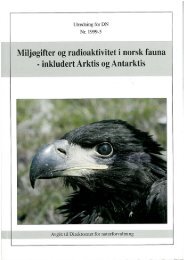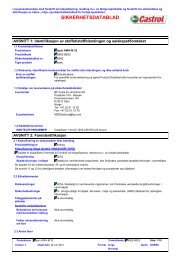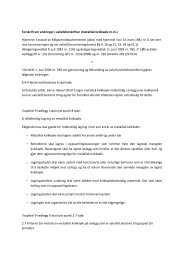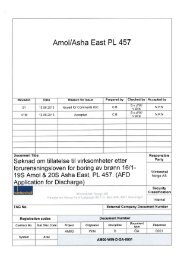Handlingsplan for kalksjøer - Direktoratet for naturforvaltning
Handlingsplan for kalksjøer - Direktoratet for naturforvaltning
Handlingsplan for kalksjøer - Direktoratet for naturforvaltning
You also want an ePaper? Increase the reach of your titles
YUMPU automatically turns print PDFs into web optimized ePapers that Google loves.
<strong>Handlingsplan</strong><strong>for</strong> <strong>kalksjøer</strong>DN-rapport 6-2011Utgiver:<strong>Direktoratet</strong> <strong>for</strong> natur<strong>for</strong>valtningDato: Oktober 2011Antall sider: 36Emneord: kalksjø, handlingsplan, utvalgtnaturtype, kransalgeKeywords: calcareous lake, action plan,selected habitat type, stonewortBestilling:<strong>Direktoratet</strong> <strong>for</strong> natur<strong>for</strong>valtning,postboks 5672 Sluppen, 7485 TrondheimTelefon: 73 58 05 00Telefaks: 73 58 05 01www.dirnat.no/publikasjonerRefereres som:<strong>Direktoratet</strong> <strong>for</strong> natur<strong>for</strong>valtning 2011.<strong>Handlingsplan</strong> <strong>for</strong> <strong>kalksjøer</strong>.ISBN (Trykt): 978-82-7072-980-7ISBN (PDF): 978-82-7072-979-1ISSN (Trykt): 0801-6119ISSN (PDF): 1890-761XLayout: Guri Jermstad ASForside:Smaltaggkrans i Vassjøtjern på Lunner.Foto: Ola HeggeEKSTRAKT:<strong>Handlingsplan</strong>en omfatter alle innsjøermed kalsiuminnhold større eller lik 20 mg/l.Etter <strong>for</strong>skrift om utvalgte naturtyper erinnsjøer med kalsiuminnhold større ellerlik 20 mg/l og med <strong>for</strong>ekomst av minsten av de følgende artene; rødkrans (Charatomentosa), smaltaggkrans (C. rudis), hårpiggkrans(C. polyacantha), stinkkrans (C.vulgaris), knippe bustkrans (C. curta), gråkrans(C. contraria), blanktjønnaks (Potamogetonlucens), sliretjønnaks (Stuckenia vaginata),vasskrans (Zannichellia palustris) eller andretruede kalkkrevende plante- eller dyrearter”Utvalgt naturtype” etter naturmangfoldlovens§ 52.Naturtypen <strong>kalksjøer</strong> er levested <strong>for</strong> relativtmange truede og sårbare arter. Flere avdisse er svært kalkkrevende og har sinutbredelse sterkt begrenset til slike sjøer.Spesielt er de fleste av Charaartene sterktkalkkrevende. I deler av landet ligger mangeav kalksjøene i kulturlandskap med stornæringssaltavrenning. Overgjødsling erder<strong>for</strong> en hovedtrussel mot mange <strong>kalksjøer</strong>og artene i disse.Målsetningen med handlingsplanen er åsikre miljø<strong>for</strong>holdene i norske <strong>kalksjøer</strong> slikat artsmangfoldet kan ivaretas så nært opptil det naturlige som mulig. Det skal leggesen særlig vekt på de <strong>kalksjøer</strong> som har størstinnslag av truede og sårbare arter som eravhengige av naturtypen.ABSTRACT:This action plan includes all lakes with acalcium content of at least 20 mg/l. Lakeswith calsium content of at least 20 mg/l andoccurrence of at least one of the followingspecies: coral stonewort (Chara tomentosa),rugged stonewort (C. rudis), hedgehog stonewort(C. polyacantha), common stonewort(C. vulgaris), lesser bearded stonewort (C.curta), opposite stonewort (C. contraria),shining pondweed (Potamogeton lucens),sheathed pondweed (Stuckenia vaginata),horned pondweed (Zannichellia palustris) orother threathened lime demanding plant oranimal species are given status of “selectedhabitat types” through a new regulationfollowing the Nature Diversity Act § 52.The habitat type calcareous lakes, is habitat<strong>for</strong> a relatively high number of threatenedand vulnerable species. Several of theserequire very calcium-rich water, and thedistribution of these species are strictlylimited to this type of lakes. Most speciesof the genus Chara have especially highcalcium requirements. In certain parts of thecountry, several of the calcareous lakes aresituated in agricultural areas with extensivedischarge of nutrients to the water. Thus,eutrophication is one of the main threats toseveral calcareous lakes and species whichmake them their habitat.The goal of the action plan is to securethat environmental conditions in Norwegiancalcareous lakes are adequate to maintainthe level of species diversity at a level asclose to natural as possible. Special attentionshould be given to those lakes whichcontain the strongest element of threatenedand vulnerable species which depend uponthis type of habitat.2


